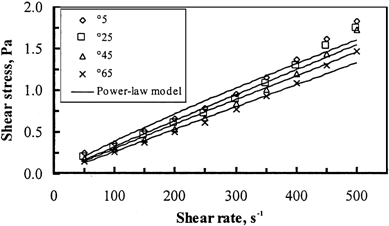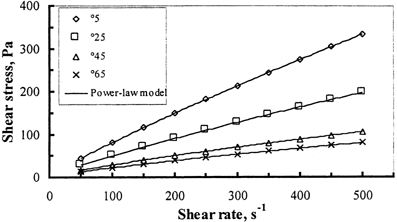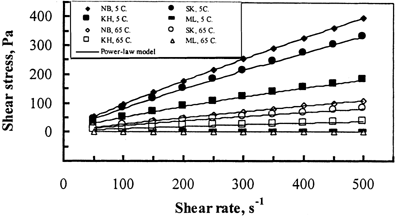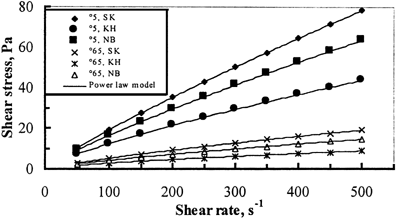Abstract
Rheological properties of date extract concentrate (dibbs), milk, and milk-dibbs drink of different dibbs concentration were experimentally determined. The dibbs was extracted from three date cultivars (Khlass, Sukkari, and Nubot Seif), and then added to milk in a specified amounts ranging from (2.5 to 15 mL dibbs/100 mL milk) to form the sweetened and nutritious milk-dibbs drinks. It was found that milk, dibbs, and milk-dibbs drinks exhibited pseudoplastic behavior following a power law model at the temperature range 5 to 65°C. The flow behavior indices ranged between 0.705 to 0.888 for dibbs and milk-dibbs drinks based on date cultivar, temperature, and concentration. For the dibbs and milk-dibbs drinks, the consistency index was found to decrease with the increase of temperature, and increase with the amount of dibbs added. Results showed a significant influence of date cultivars on the rheological properties of dibbs and milk-dibbs drink. Utilizing the Arrhenius model, the activation energies ranged from 5×103 kJ kg−1 mol−1 to 21× 103kJ kg−1 mol−1 at shear rate 100 s−1.
NOTATION
| E a | = |
Activation energy (kJ kg−1 mol−1) |
| K | = |
Consistency index (Pa s n ) |
| K ∞ | = |
Frequency index (Pa s n ) |
| n | = |
Flow behavior index (dimensionless) |
| r 2 | = |
Determination coefficient (dimensionless) |
| R | = |
Universal gas constant (8.314 kJ kg−1 mol−1 K−1) |
| T | = |
Absolute temperature (K) |
| = |
Products | |
| ML | = |
Milk |
| KH | = |
Dibbs of Khlass date cultivar |
| SK | = |
Dibbs of Sukkari date cultivar |
| NS | = |
Dibbs of Nubot Seif date cultivar |
| SS | = |
Soluble solid |
| = |
Greek Letters | |
| μ | = |
Viscosity (Pa s) |
| μ a | = |
Apparent viscosity (Pa s) |
| μ∞ | = |
Frequency factor (Pa s) |
| τ | = |
Shear stress (Pa) |
| γ˙ | = |
Shear rate (s−1) |
INTRODUCTION
To enhance milk taste and flavor especially for kids and in school meals, the dairy industries introduced several flavoring ingredients to milk such as chocolate, vanilla, banana, and strawberry. Frequently, for such milk drinks, sugar is added with those flavored ingredients to serve as sweetener. Concentrate of the date-water extract (dibbs) from date fruit can be a unique additive to milk. It can serve as a nutritious, brown coloring, flavoring, and sweetener. Moreover, milk-dibbs drink is natural and contains no artificial additives or preservatives.
Saudi Arabia is self-sufficient in the production of both commodities; dates and milk. The date fruit of date palm trees (Phoenix dactylifera L.) is the most widely grown fruit in Saudi Arabia. Annual production in 1998 is estimated to be 650,000 tons of more than 450 different date cultivars, produced from over 18 million date palm trees spread throughout the countryEquation1. During the last decade, some of the factories diversified their date products to manufacture date paste, date syrup (dibbs), date jam, date vinegar, and animal fodder from low-grade dates. Recently, some date factories began production of commercial quantities of date dibbs. Yet, one of the problems facing this production is the limited utilization of dibbs, especially lack of marketing as a sweetener at an industrial scale level. The milk production is estimated to be 581 million liters in 1998 Citation[1].
It is expected that the introduction of a newly developed drink from milk and dibbs to the food industry would mark a commercial success for both commodities. Because of both nutritive value and sweetness of the dibbs, it is highly anticipated that it would be a competitive ingredient comparable to or probably better than chocolate, vanilla, banana, and strawberry flavors typically added to milk.
To introduce this milk-dibbs drink to the food industry, dairy industry in particular, there is a need to provide basic rheological properties of such product. Those data are essential in the design of thermal processing including cooling, pasteurization, and sterilization; and in fluid flow characteristics including pumping, pipe sizing, and homogenization. There are several studies on milk flavored by chocolate Citation2-11 and banana Citation12-13, Citation[11], and strawberry Citation14-15. Furthermore, there are several studies which investigated the rheological properties of dibbs of high °Brix Citation16-17. However, there is no published work investigated the rheological properties of milk-dibbs drink.
The objective of this paper was to measure and determine the basic rheological properties of the milk-dibbs drink at different concentrations, processing temperatures, and dibbs extracted from different date cultivars.
MATERIALS AND METHODS
Sample Preparation
Milk was bought from local market [sterilized full cream milk (3.0% fat and 87.9% water content] in a half liter container. Dibbs (concentrated date-extract) from three- selected date cultivars (Nubot Seif, Sukkari, and Khlass) were purchased from a local date processing plant. The process of producing dates dibbs was in three stages: extraction of sugar by mixing added water with dates (3:1 of water:dates, w/w), filtration, and concentration under vacuum to 75.28 °Brix (±0.1) date dibbs.
The milk-dibbs drinks were prepared at six mixes by adding specified amount of dibbs to 100 mL milk. The amount of dibbs added for milk-dibbs drinks and their soluble solid content are shown in Table .
Table 1. Average Soluble Solid Content of Milk, Dibbs, and Milk-Dibbs Drinks at Different Mixes
Rheological Measurements
Rheological parameters of samples were measured using a cone and plate type version (Brookfield DV-III Programmable Rheometer, Brookfield Engineering Laboratories. Inc, Stough, MA, USA) connected to a water bath (Brookfield Refrigerated Bath/Circulator Model TC-500, Brookfield Engineering Laboratories. Inc, Stough, MA. USA). The sample was placed into sample cap. The cone was rotating at specified speed to obtain shear rate while the corresponding torque was used to measure shear stress. The speed of the rotating cone was in the range of 0 to 500 revolution per sec.
Model and Statistical Analysis
Several related rheological models were examined to characterize the flow behavior of milk, dibbs, and milk-dibbs drinks.
Newtonian model:
Power-law model:
The dependence of apparent viscosity on temperature for milk-dibbs drinks would be described using Arrhenius model:
Where apparent viscosity can be derived, at specified shear rate, from the relation:
A statistical and spreadsheet programs were used to analyze the data and predict model parameters.
RESULTS AND DISCUSSION
Rheological Parameters (n and K)
Rheological parameters of dibbs, milk, and milk-dibbs drinks are listed in Tables and . It was found that the best model that represents the rheological flow behavior of dibbs, milk, and milk-dibbs drinks is the power law model in which the correlation coefficient ranged between 0.977 to 0.999.
Table 2. Rheological Parameters (Consistency Index (K) and Flow Behavior Index (n)) of Milk and Dibbs at Temparatures (5 to 65°C) for Different Date Cultivars
Table 3. Rheological Parameters (Consistency Index (K) and Flow Behavior Index (n)) of the Milk-Dibbs Drink at Different Dibbs Concentrations (2.5 to 15 mL Dibbs/100 mL Milk) at Temperatures (5 to 65°C)
For Milk and Dibbs
As shown in Table , the flow behavior index of milk indicated the closeness of flow behavior to Newtonian fluid (e.g., n=1) with the increase of temperature. As expected, the increase of temperature decreased the consistency indices for all runs. Figure shows an appreciable influence of temperature on the curves of shear stress versus shear rate. The highest values of shear stresses were at 5°C while the lowest were at 65°C at constant shear rate.
Figure shows the influence of temperature on the flow behavior of Sukkari dibbs. Contrary to milk, the increase of dibbs temperature decreases the values of flow behavior index, thus deviate from Newtonian flow to pseudoplastic behavior (n<1). There are some trends of some studies Citation16-17 indicating this phenomenon for the effect of temperature on the flow behavior index of dibbs for different date cultivars. Yet, there is a need for further chemical analysis to examine the effect of temperature on the structure and composition changes of dates especially the content and type of reducing sugars. Figure shows that increase of dibbs temperature tends to lower the shear stress, hence reducing the resistance to flow. It is interesting to note the large variations of required shear stresses when comparing milk and dibbs curves as can be seen in Figs. and . Shear stresses of dibbs is about 200 folds that of milk, which again illustrate the high flow resistance of dibbs. Table also indicates that consistency index values of milk are much lower than that of dibbs, which is mainly due to the high solid content of dibbs (75.3% compared to 12.13% of milk). This reflects again the importance of considering the higher pumping requirements and the lower heat transfer rates of dibbs compared to milk. There was an appreciable variation of flow behavior of dibbs for the different cultivars studied. It was found that consistency indices for Khlass dibbs were the lowest for all temperatures examined. This can be attributed to the variations of chemical composition of date cultivars, i.e., reducing, non-reducing, and total sugar content. The variations of flow behavior of milk and dibbs of different cultivars at 5 and 65°C are illustrated in Fig. . In both temperatures, Nubot Seif exhibited the highest shear stresses, then Sukkari, and finally Khlass cultivar.
For Milk-Dibbs Drinks
Rheological parameters of milk-dibbs drinks as influenced by added dibbs (v/v), temperature, and dibbs date cultivars are listed in Table . The amount of dibbs added to milk influenced the flow behavior of milk-dibbs drink. As can be seen in Figs. and , the increase of dibbs concentration increased the shear stresses for all runs. Similar to dibbs, milk-dibbs drinks exhibited pseudoplastic behavior but (n) decreased with the increase of temperature as shown in Table . This indicates that dibbs has a significant influence on the rheological properties of milk-dibbs drinks. This in effect would decrease the flow resistance of milk-dibbs drink with the increase of velocity; in oppose to the dilatant behavior (n>1) in which the flow resistance would increase. It should be noted here that the magnitude of shear stresses at 5°C is about five times that at 65°C for the same shear rates as can be seen for Figs. and .
Figure 4. A comparison of the flow behavior for milk, dibbs, and milk-dibbs drinks at different added dibbs of Sukkari cultivar at 5°C.
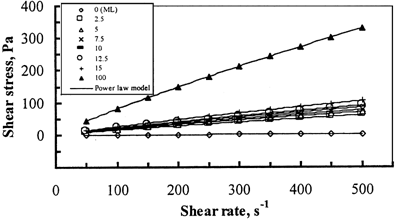
Figure 5. A comparison of the flow behavior for milk, dibbs, and milk-dibbs drinks of Sukkari cultivar at 65°C.
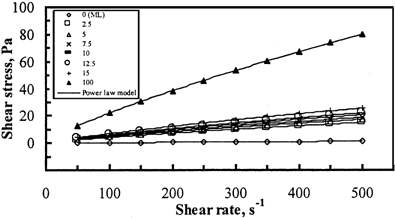
It was found that date cultivar influenced shear stresses of milk-dibbs drinks; in which Khlass cultivar was the lowest at specified shear rates as can be noted in Fig. . for two temperatures at specified dibbs concentration.
Apparent Viscosity and Activation Energy
Since the flow behavior of the samples examined is non-Newtonian, the apparent viscosity can only be expressed at specified shear rate. This expression would facilitate studying the effects of added dibbs (v/v), temperatures, and date cultivars on viscosity. Furthermore, the apparent viscosity at other shear rates would be influenced similarly. The apparent viscosity (Eq.Equation4) was calculated for all runs at shear rate (100 s−1), and then plotted in Figs. , and . It is evident that the increase of temperature decreased the apparent viscosity for all samples of milk, dibbs, and milk-dibbs drinks. The figures also supported earlier discussion that the increase of added dibbs increased the apparent viscosity. The above observations were noticed for all date cultivars examined in this study. Comparing Figs. , and , it can be noticed that apparent viscosity is the lowest for milk-dibbs drink for Khlass cultivar, then Nubot Seif, and finally Sukkari. This variation can be attributed to the different composition of date cultivars.
Figure 7. Apparent viscosity as influenced by added dibbs of milk-dibbs drinks at different temperatures for Khlass cultivar at 100 s−1.
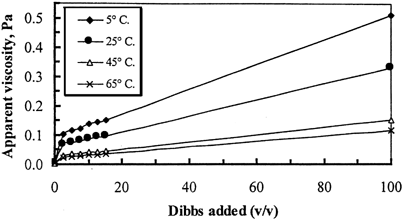
Figure 8. Apparent viscosity as influenced by added dibbs of milk-dibbs drinks at different temperatures for Nubot Seif cultivar at 100 s−1.
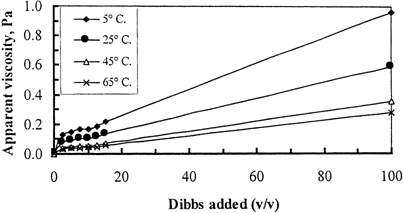
Figure 9. Apparent viscosity as influenced by added dibbs of milk-dibbs drinks at different temperatures for Sukkari cultivar at 100 s−1.
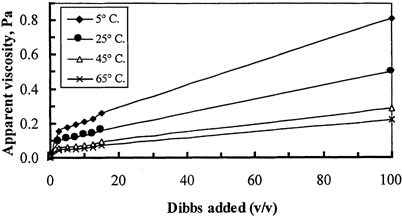
From the apparent viscosity and temperature data, the activation energy and frequency factor were calculated utilizing Eq. Equation3 and μ a versus 1/T plots. Table shows both parameters (μ∞ and Ea ). The range of activation energies is from 5053 to 20895 kJ kg−1 mol−1 based on the amount of dibbs added and the date cultivar of dibbs at shear rate of 100 s−1.
Table 4. Activation Energy of Flow/and Frequency Factor of Milk, Dibbs and Mi1k-Dibbs Drink at Constant Shear Rate (100 s−1)
From the data of Table , the dependence of consistency index on temperature for milk-dibbs drinks can be described using Arrhenius model:
The constants K ∞ and activation energy are shown in Table . The table showed a good correlation as indicated by the high values of determination coefficients (0.991–0.998).
Table 5. Constants of Arrhenius Equation at Different Milk-Dibbs Concentrations
CONCLUSION
Milk-dibbs rheological behavior was evaluated at different dibbs concentration, date cultivar, and temperature. The flow behavior indices (n) ranged between 0.705 to 0.888 for dibbs and milk-dibbs drinks exhibiting a pseudoplastic behavior. The consistency index was found to decrease with the increase of temperature, but increase with the amount of dibbs added. It was found date cultivars had a significant influence on the rheological properties of dibbs and milk-dibbs drink. The Arrhenius model was utilized to calculate activation energies (ranged from 5×103 kJ kg−1 mol−1 to 21× 103 kJ kg−1 mol−1) at specified shear rate of 100 s−1.
Acknowledgments
REFERENCES
- 1999 . “ Ministry of Agriculture. Agriculture Statistical Year Book ” . 12 Saudi Arabia
- Hashim , L. and Chaveron , H. 1997 . Influence of Whey Proteins on the Rheological and Sensory Characteristics of Chocolate . Proceedings of the Second International whey Conference . 1997 , Chicago. pp. 206 – 213 . 27–29 October 1997
- Hamad , A.M. , Al-Kanhal , H.A. and Al-Sheikh , S.S. 1987 . Chocolate-flavored Drink from Sweet Whey-milk Blend Sweetened with Date Puree . Journal of Food Prot , 50 ( 5 ) : 398 – 400 .
- Full , N.A. , Reddy , S.Y. , Dimick , P.S. and Ziegler , G.R. 1996 . Physical and Sensory Properties of Milk Chocolate Formulated with Anhydrous Milk Fat Fractions . J. Food Science , 61 ( 5 ) : 1068 – 1072, 1084 .
- Hough , G. , Sanchez , R. , Barbieri , T. and Martinez , E. 1997 . Sensory Optimization of a Powdered Chocolate Milk Formula . Food Quality and Preference , 8 ( 3 ) : 213 – 221 .
- Schenz , T.W. 1997 . Using Rheology of Weak Gels to Improve Fluid Foods . Food Technology, Chicago , 51 ( 3 ) : 83 – 85 .
- Dimick , P.S. , Ziegler , G.R. , Full , N.A. and Reddy , S.Y. 1996 . Formulation of Milk Chocolate Using Milk Fat Fractions . Australian Journal of Dairy Technology , 51 ( 2 ) : 123 – 126 .
- Dewettinck , K. , Moor , H. de , Huyghebaert , A. and De , Moor H. 1996 . The Free Fat Content of Dried Milk Products and Flow Properties of Milk Chocolate . Journal of Milchwissenschaft , 51 ( 1 ) : 25 – 28 .
- Aguilar , C.A. and Ziegler , G.R. 1995 . Viscosity of Kmolten Milk Chocolate with Lactose from Spray-dried Whole-milk Powders . Journal of Food Science , 60 ( 1 ) : 120 – 124 .
- Haylock , S.J. and Fayerman , A.M. 1991 . Properties of Milk Chocolate and the Effect of Milk Solids . Conference Proceedings of Food Ingredients Asia , : 157 – 160 .
- Hamza and Chaffai , A. 1990 . Rheological Characterization of Chocolate Jellified Milk: Optimization of Manufacturing Technology . Journal of Lait Lyon , 70 ( 2 ) : 155 – 167 .
- King , A.E. , Su , J.T. and Huang , S.C. 1993 . Effect of Banana Paste Addition on the Survival of Lactobacillus Acidophilus in Acidophilus Milk after Spray Drying . Journal of Chinese Agricultural Chemical Society , 31 ( 1 ) : 68 – 77 .
- Paoletti , F. , Quaglia , G.B. , Menesatti , P. and Bertone , A. 1992 . Mechanical Characterization of Freeze-dried Shakes Composed of Banana and Milk . Lebensmittel Wissenschaft and Technologie , 25 ( 1 ) : 26 – 28 .
- Basak , S. and Ramaswamy , H.S. 1994 . Simultaneous Evaluation of Shear Rate and Time Dependency of Stirred Yogurt Rheology as Influenced by added Pectin and Strawberry Concentrate . Journal of Food Engineering , 21 ( 3 ) : 385 – 393 .
- Keating , K.R. and White , C.H. 1990 . Effect of Alternative Sweeteners in Plain and Fruit-flavored Yogurts . Journal of Dairy Science , 73 ( 1 ) : 54 – 62 .
- Hassan , B.H. 1992 . Viscometric Behaviour of Single Strength and Concentrated Date Water Extracts . Journal of King Saud University, 4, Agricultural Sciences , : 3 – 13 .
- Hobani , A.I. 1998 . Rheological Behaviour of Date-water Concentrates . Journal of Food Engineering , 36 : 349 – 357 .
